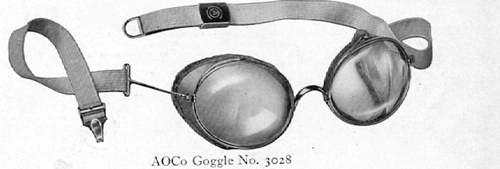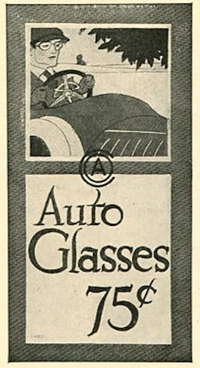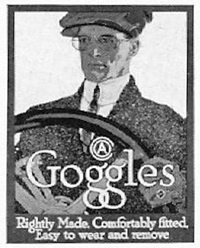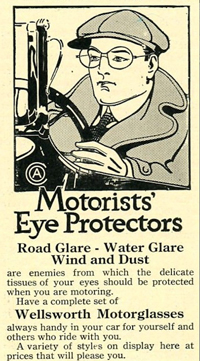
Ask someone today about high tech eyewear, and they will probably mention Google Glass. But do they know that 100 years ago, the most high tech eyewear was goggle glasses? Or that the emergence of the auto had as much impact on eyewear as the invention of the computer—and is still changing it today?

Driver Goggles from American Optical (1914).
Image courtesy of Carl Zeiss Vision
 Auto Glasses for 75 Cents? (1917).
Auto Glasses for 75 Cents? (1917).
Image courtesy of Carl Zeiss Vision
The eyeglasses that worked well for day-to-day life weren’t suited for the stresses and demands of motorists—especially with those open-air vehicles and unpaved roads of those early days of driving.
American Optical, now part of Carl Zeiss Vision, played a key role in developing new technologies and designs that met the needs of drivers of the day. These innovations influenced, in turn, the evolution of the automobile. Newly released materials from the company’s archives document this fascinating history.
This story begins with those high tech goggle glasses! Around 1910, goggles became stylish fashion accessories, along with heavy driving coats and scarves. Driving goggles were often lined with fur or leather, and signaled that the wearer was affluent and tech savvy.
The same way a consumer today might flaunt an Apple Watch, the trendiest people of a century ago made sure that you would see their fashionable driving eyewear.
 Goggles Ad from American
Goggles Ad from American
Optical (1914).
Image courtesy of
Carl Zeiss Vision
But driving glasses were more than just a style statement and vision enhancement, even back then. They needed to deliver a wide range of additional benefits. Grit and particles could get into the eye, and high-performance spectacles needed to offer safety protection. The earliest commercial automobiles didn’t come with windshields—those weren’t a standard option until around 1915.
For many years, eyewear itself was the only thing separating drivers from oncoming objects. The windshield aimed to take the role previously served by goggles. But with only mixed results—the early windshields shattered easily, and cautious motorists still needed to keep their eyes protected while behind the wheel.
 Motorist Eye Protectors from American
Motorist Eye Protectors from American
Optical (1917).
Image courtesy of
Carl Zeiss Vision
But drivers often had the most to fear from other drivers. No driver’s licenses were required in the U.S. before 1910, and as late as 1927, only five states mandated vision tests for motorists. Before the government stepped in, the eyewear field played the key role in ensuring safety on the roads.
The early history of this amazing shift in eyewear is mostly forgotten today. But fascinating materials shared this month by Carl Zeiss Vision, in conjunction with the launch of its new DriveSafe lenses, call attention to the long, strange history of automotive eyewear.
These exhibits are drawn from the collection of the Optical Heritage Museum in Southbridge, Massachusetts, sponsored by Zeiss to promote and display materials from the company’s American Optical archives. “Zeiss and American Optical laid the foundations for most of the eyewear field as we know it today,” remarked Zeiss vice president Karen Roberts. “When the two companies came together in 2005, this not only represented a powerful business partnership but the union of the two organizations that invented modern eyewear—for drivers and everyone else. We want to make more of these historical materials available online and in traveling exhibits.”
“Drivers still require the best technology for their vision needs today,” added Roberts. “Surveys show over two-thirds of adults have difficulty in driving in low light or adverse weather conditions. Our new DriveSafe lenses address problems of glare, depth perception, and vision acuity at all distances. We are proud to represent a long history of meeting the special needs of motorists, and also to remain at the forefront of the field in the current day.”
These exhibits are drawn from the collection of the Optical Heritage Museum.